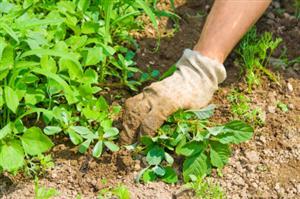| Complexity level: | 8 |
| Project cost ($): | 30 |
| Time required: | 2 hours to prepare, 12 days for science fair project |
| Material availability: | May be purchased from a plant nursery |
| Safety concerns: | Handle chemicals with care and dispose of them properly. Wear safety gloves and goggles to prevent injury |
Hypothesis
The higher the concentration of Bay laurel leaf juice, the faster the rate at which weeds are killed.
Overview
Allelopathy
Allelopathy describes a condition where a species of plant releases certain chemical substances that are able to inhibit the growth or seed germination of another species of plant. This naturally occurring condition will affect the diversity, structure and growth of the plant ecosystem.
Plants and animals have to compete for space, food and water. In the case of plants, they have to compete for water, nutrients from the soil and sunlight. Plants that are allelopaths have developed chemical means of inhibiting their competitors from growing or preventing their competitors’ seeds from germinating nearby, in order to eliminate competition for resources.
The substances that are released by allelopathic plants are quite similar to herbicides. The source of the allelopathic substance can be the leaves, flowers, tree bark or the roots of the allelopathic plant. Some of the chemicals that are produced by the plants can remain rather persistently in the surrounding soil over a long period of time while others may degrade fairly quickly.
Scientific Terms
Materials
The materials required for this science fair project:
- 5 pots of weeds
- 1 kg of Bay laurel leaves
- 1 juice extractor
- 1 measuring cylinder
- 5 spray bottles
- tap water
- 1 black marker pen
Procedure
1. For this science project, the independent variable is the concentration of the juices from the Bay laurel leaves – 25%, 50%, 75% and 100%. The dependent variable is the time taken for the weeds to change color and the weeds to become dry and dead. This is determined by observing the weeds every day. The constants (control variables) are the size of the pot and the amount of Bay laurel leaf juice used.
2. The 5 pots of weed and the 5 spray bottles are labeled as 0%, 25%, 50%, 75% and 100%.
3. The 1 kg of Bay laurel leaves are placed inside the juice extractor with some water added to help extract the juice. The extracted juice is mixed with tap water at the following ratios and poured into the marked spray bottles:
a. Spray bottle marked 0% - only 200ml tap water used
b. Spray bottle marked 25% - 50ml Bay laurel juice with 150ml tap water
c. Spray bottle marked 50% - 100ml Bay laurel juice with 100ml tap water
d. Spray bottle marked 75% - 150ml Bay laurel juice with 50ml tap water
e. Spray bottle marked 100% - 200ml Bay laurel juice
4. For the next 12 days, the mixed solution in the spray bottles is sprayed over the weeds in the pot. The marking on the pots containing the weeds must be the same as the marking on the spray bottles.
5. The conditions of the weeds are observed everyday for the next 12 days. Observations are made on the color changes in the weeds in order to verify if the weeds are alive or dead. The observations are recorded in the table given below.
Results
The results showed that increasing the concentration of the Bay laurel leaf juice helped kill the weeds more quickly.
| Concentration | Bay laurel leaf juice concentration and weed survival | |||||||||||
| Day1 | Day2 | Day3 | Day4 | Day5 | Day6 | Day7 | Day8 | Day9 | Day10 | Day11 | Day12 | |
| 0% | Y | Y | Y | Y | Y | Y | Y | Y | Y | Y | Y | Y |
| 25% | Y | Y | Y | Y | Y | Y | Y | Y | O | O | O | O |
| 50% | Y | Y | Y | Y | Y | Y | O | O | O | O | X | X |
| 75% | Y | Y | Y | Y | O | O | O | O | X | X | X | X |
| 100% | Y | Y | Y | O | O | O | X | X | X | X | X | X |
Y - weed still healthy, O – weed color changed, X – weed is dead
Conclusion
Our hypothesis was that the higher the concentration of Bay laurel leaf juice, the faster the weeds would be killed - has been proven to be correct.
The use of synthetic weed killers is known to be a health hazard to the environment. These herbicides leach into ground water and causes contamination of the water table. Ponds and rivers become contaminated and endanger the lives of organisms . The use of allelopathic plants to combat the weed problems is a safer and eco-friendlier solution.
Also consider
This science project can be repeated using different types of allelopathic plants like the California buckeye. Also, try comparing the difference in effectiveness between natural vs. synthetic weed killers.
References
Allelopathy in gardening - http://society.indianetzone.com/gardening/1/allelopathy.htm
Allelopathic plants: nature’s weed killers - http://earthfriendlygardening.wordpress.com/2006/11/30/allelopathic-plants-natures-weedkillers/
Umbellularia Californica - http://www.laspilitas.com/nature-of-california/plants/umbellularia-californica

